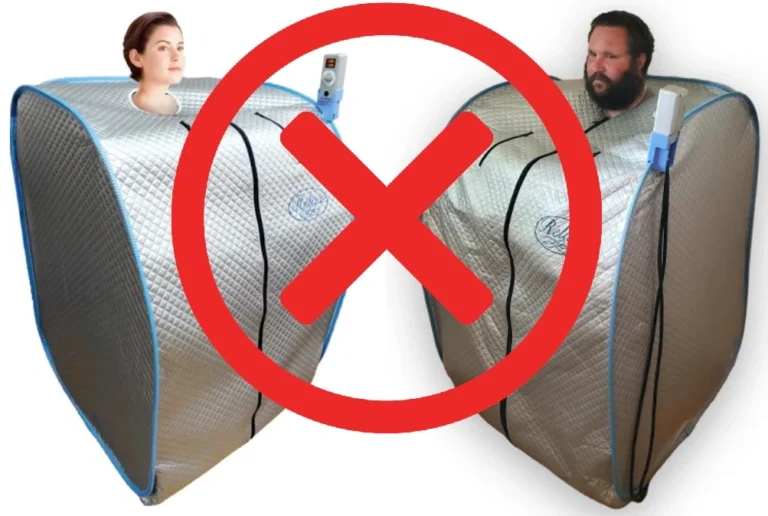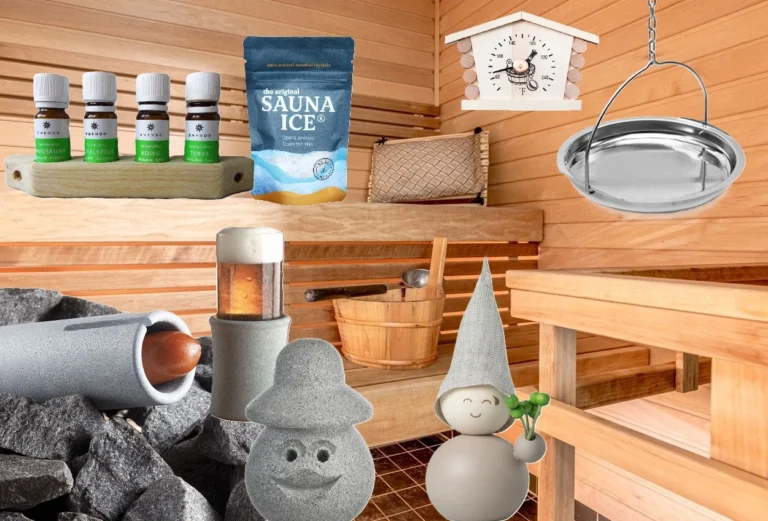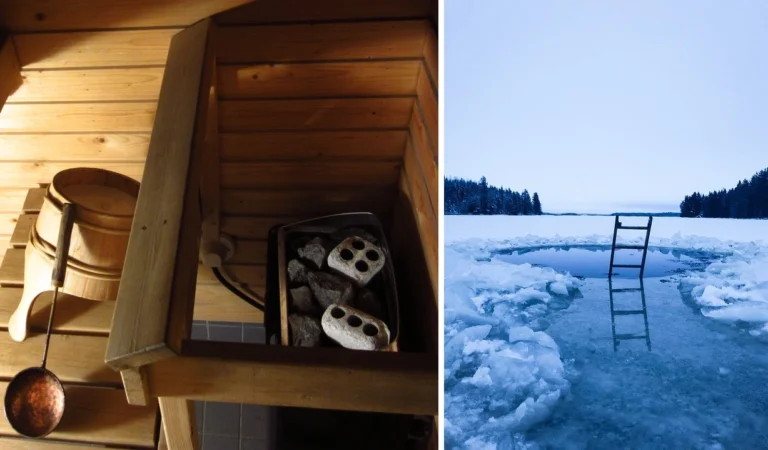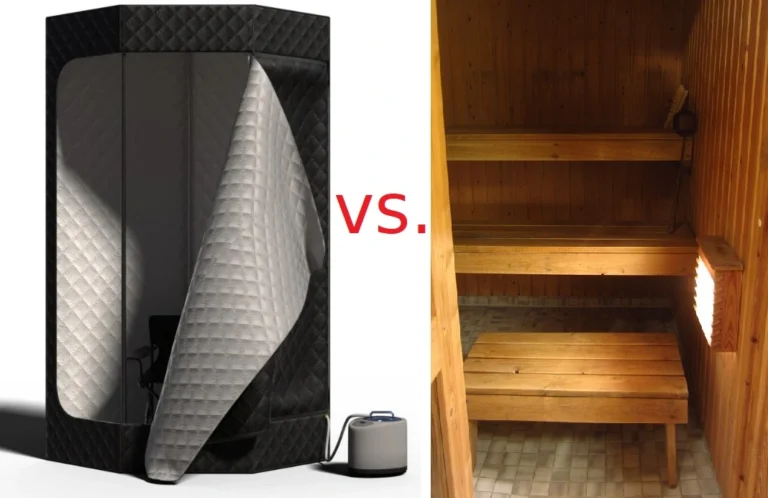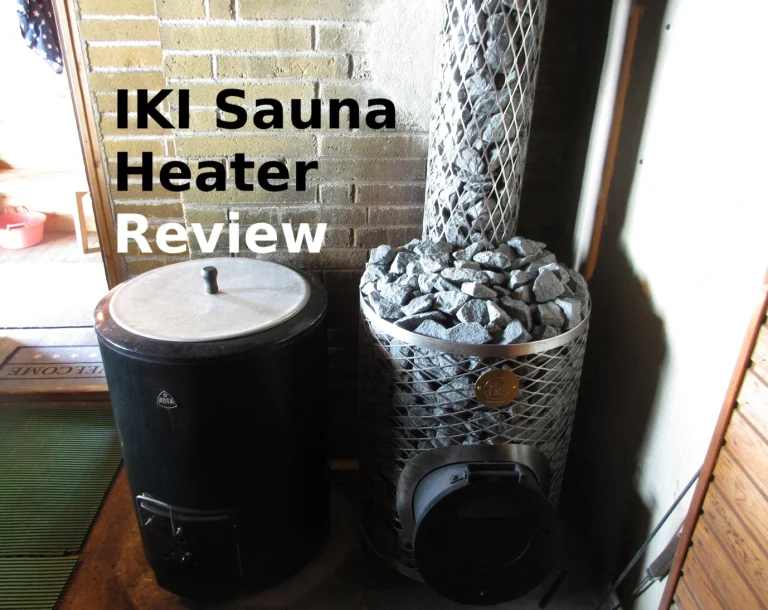15 Sauna Types (with Pros & Cons): Find the Perfect One
So you’ve been thinking about getting a sauna of your own? Or at least you’re curious about what types of saunas for home the current selection has to offer to a sauna-goer like you?
Great, you’ve come to the right place!
In this article I will list and discuss sauna types and some of their variations in detail, including the pros and cons of the main types.
Having over 35 years of sauna experience and Finnish roots, I’m happy to tackle the many misconceptions I’ve come across when reading about sauna types online, the biggest of which is the concept of dry vs. wet sauna.
Let’s start typing saunas and clearing up common false ideas to help you find the right one!

What different saunas are there? All types of saunas are either indoor or outdoor saunas.
Some portable “saunas” can be used both indoors and outdoors, but they aren’t real saunas as they don’t meet the definition of sauna.
I find it makes more sense to categorize saunas as indoor and outdoor saunas than using lacking labels such as electric sauna or wood-burning sauna because many different sauna types can have an electric or a wood-fired stove.
You wouldn’t be able to differentiate a traditional outdoor sauna from a barrel sauna, for instance, if you just called them both wood-burning saunas. As there are crucial differences between these two sauna types, it’s not fruitful to clump them together.
With all this in mind, let’s jump in.
Indoor Sauna Types
1. Bathroom sauna

This is one of the most common sauna types: a bathroom sauna is a separate sauna room you access directly through your bathroom.
This type usually comes with an electric sauna heater, the rocks of which you’re always supposed to throw water on to produce steam (löyly).
Never buy an electric sauna stove from anyone who tells you water isn’t allowed! They either have no idea what they’re talking about (i.e., they haven’t even read the instruction manual) or worse, the heater really can’t tolerate water, which means it’s not a real sauna heater and not worth your money in the first place.
Contrary to popular belief, a bathroom sauna can alternatively have a wood-burning stove (I’ve personally been to such saunas many times) although it’s becoming increasingly rare and is more difficult to install afterwards because a chimney is needed.
Electric heaters are much more widely used and the only option in apartment buildings.

Bathroom saunas are also sold as ready-made modules such as the ones above: sauna types like these are ideal when your bathroom is big enough to fit a sauna but you don’t have a pre-existing, separate room with walls in your bathroom (just like most homes in most countries don’t).
A modular sauna comes in several shapes, such as a corner sauna or a rectangular sauna, and can also be placed elsewhere in your home (like a garage, for instance) although bathroom is still the best and most common location.
That’s because saunas can get very humid and should have proper ventilation; a bathroom already has a ventilation system and is equipped to handle humidity and wetness like no other room in your home.
A small bathroom sauna is one of the easiest sauna types to install and requires no expert help as you just assemble the sauna and plug the heater in; with the smallest heaters, no electrical work is needed either.
Pros
Cons
2. Infrared sauna
This is the latest of all sauna types although it’s not a real sauna to begin with.
But who cares about labels if you like dry heat, color-changing LED lights and/or music in your sauna?
An infrared sauna uses infrared heaters to emit infrared light which is radiant heat just like the heat from the sun. Infrared saunas heat your body directly without significantly warming the air around you.
They heat up more quickly than traditional saunas and operate at lower temperatures, usually between 100 F and 135 F (40 C to 55 C).

While a traditional sauna is NEVER meant to be used dry (we’ll get to the dry vs. wet sauna part further down this article), an infrared sauna is the only dry sauna that exists as it won’t produce any steam.
The health benefits of infrared saunas have been studied far less than traditional sauna benefits, but are claimed to include pain relief, improved circulation, and stress reduction.
What is the healthiest type of sauna? If health benefits are your main motivator for getting a sauna, and you’ve read that infrared saunas offer the most health benefits, you should know you were lied to.
While there’s no evidence suggesting infrared heat rooms are better sauna types for your health than traditional saunas, there’s a lot of research supporting the use of traditional saunas.
But if you’ve been to an infrared sauna and loved the experience, there can still be many pros:
Pros
Cons
3. Hybrid sauna
This type combines the features of a traditional and an infrared sauna: there’s a sauna heater with rocks you’re supposed to throw water on to form steam, and infrared panels to give you dry, radiant heat.
Both features (infrared and traditional) can’t be enjoyed at the same time with most, if any, hybrid saunas.
This means that if two people want to go to sauna at the same time, one preferring infrared heat and the other traditional steamy heat, they can’t sauna together but have to use it at different times.
4. Steam sauna
This should be called a steam room, as it’s not a sauna, but it made it to this list simply because some people think of it as one of the sauna types out there.
While heavy steam can be a nice experience at the spa, steam rooms are not recommended for home use because they form too much moisture and humidity, and professional builders are required. Even with professional help, it still can’t be guaranteed that all the steam won’t lead to mold problems.
Whereas traditional saunas typically have high humidity levels (= steam) and drier air alternating, steam rooms are all about wetness and thick-feeling air caused by boiling water in a generator.
If you’re still wondering what a steam room is, just think of the steam room incident that happened to Chandler in Friends. Yikes!
For many people, the sweet spot is somewhere in the middle of a super dry sauna and an extremely wet room filled to the brim with heavy steam.
5. Sauna-shower combination
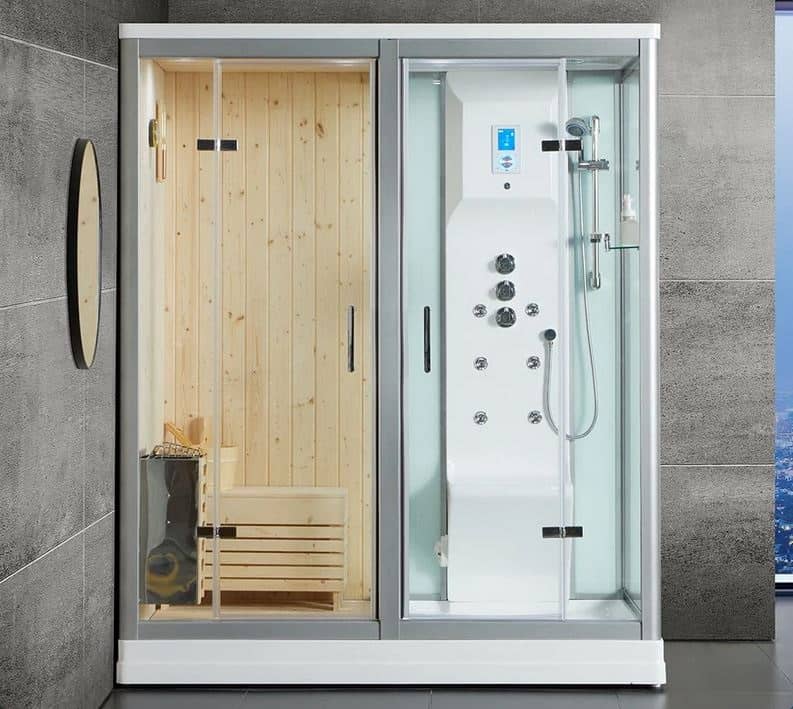
This is a tempting option if you want to combine the best worlds of a steam room and a traditional sauna.
Some manufactures mistakenly call a mere steam shower a sauna-shower combination (where’s the sauna in that equation?), but others do it right like Aquapeutics.
Above we have an actual steam shower room and a sauna section with a real electric sauna heater that you fill with sauna rocks and pour water on them.
In a solution like this, moisture and humidity won’t pose a problem like they would in a spa-like steam room because the space is tightly enclosed and comes with a ventilation fan.
6. Portable sauna
Portable indoor “saunas” deserve the biggest air quotes, meaning it’s difficult to find saunas more fake than these.
These sauna types are well represented on Amazon and are the most gimmicky of them all: commonly you’ll encounter a 1-seater with the user’s head sticking out.
The heat these booths and plastic boxes produce comes from infrared panels or electric steam generators.
Above, you can see a dry, infrared panel version in video format whereas below we have a steamy version.
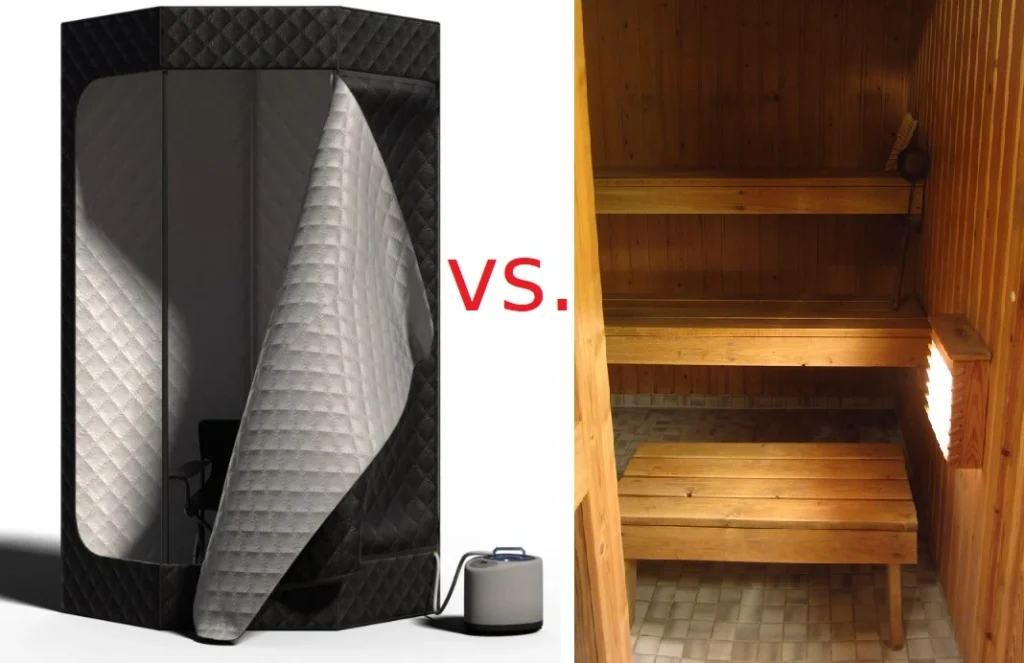
It goes without saying that these sauna types don’t represent real saunas and certainly don’t increase your home’s value, but I was still able to think of a few pros:
Pros
Cons
Outdoor Sauna Types
When talking about outdoor saunas, they typically all have a wood-burning stove although an electric heater or infrared panels are also possible.
Because of this, outdoor saunas mostly vary only by shape and/or building materials.
7. Traditional wood-burning sauna
This is the mother of all sauna types and can also be called a traditional Finnish sauna: you throw water on the hot sauna rocks to produce steam (löyly) that spreads throughout the sauna.
A wood-burning stove is the best and most common heat source for this type of sauna. Some manufacturers do sell electric heaters for outdoor saunas, too, but they can get really expensive to use especially during winter months when it’s freezing outside. Plus, why rely on electricity when you don’t have to?
There are also propane sauna heaters meant only for outdoor saunas, but personally I don’t see any reason to choose them over other models. (Maybe if you live on an island where no trees grow?)
Below, you can see my outdoor sauna that my dad and I built:
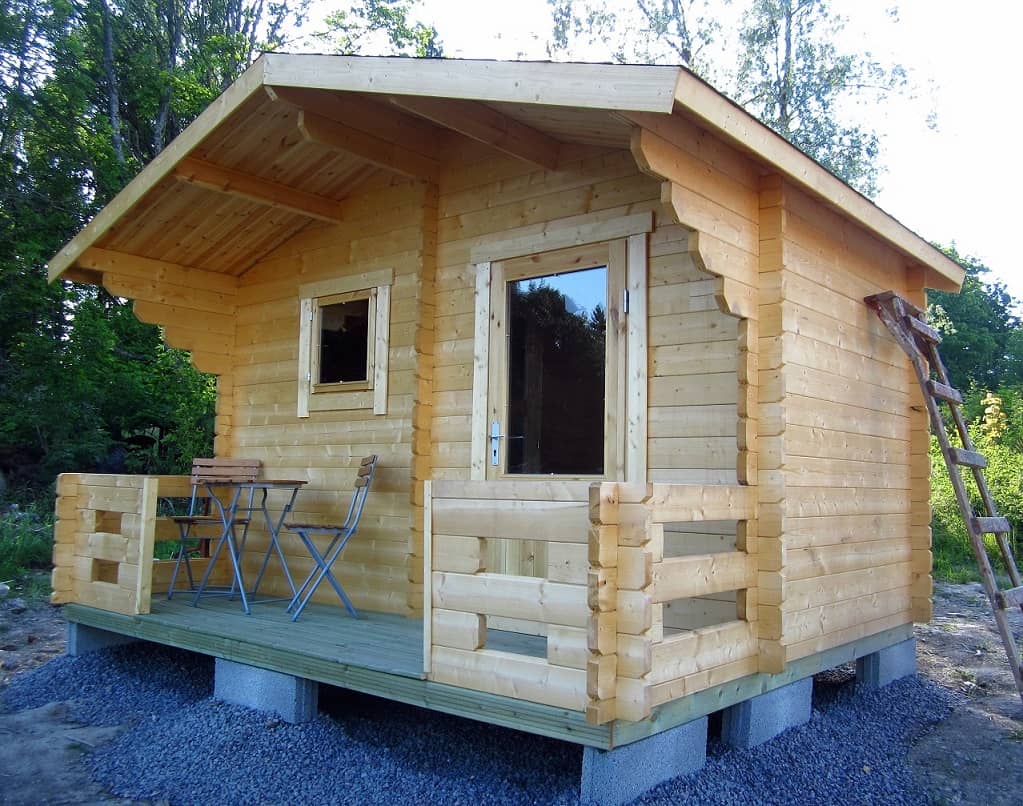
This type of traditional wood-burning sauna comes with a deck and a changing room which is also great for storing wood for the stove.
When sauna shopping, you’ll find some outdoor sauna types come with all the trimmings while others offer just the sauna room and nothing else, not even a stepping surface, let alone a roof over your head or a hanging-out area.
When your sauna doesn’t have a changing room, you’re forced to step out and leave the sauna naked: that may not be a problem in a more secluded area, but if your yard is more open-plan, and you have curious neighbors, the lack of privacy may start to bother you.
And, just to be super clear, you’re not supposed to wear clothes in your home sauna! Even some commercial saunas don’t allow clothes.
If your sauna doesn’t include a changing room, the biggest con, though, is that when entering and leaving the sauna room, the heat is able to escape more freely than when you have a barrier (= changing room) between the hot sauna and possibly the cold or even freezing outdoor air.
Pros
Cons
8. Log sauna / sauna cabin
While my sauna above is made from logs cut to timber, you can use whole logs if you prefer.
This is one of the sturdiest sauna types there are. With logs, you don’t even have to consider insulation because the walls are very thick to begin with.

9. Barrel sauna
If you like the aesthetic, barrel saunas are fun sauna types to look at. Some are also quite compact and potentially a good choice if you’re dealing with space constraints.
Do barrel saunas have any benefits that all outdoor saunas don’t have? Yes, some horizontally placed barrel saunas come with an important pro: the “foundation” is included in the package. A barrel naturally needs something to hold it in place, and it is exactly this stand that also functions as a foundation.
That’s a big deal because many people don’t build a proper foundation for their sauna, which can lead to mold and much later to a soft, decomposing floor, leaving your whole sauna ruined and beyond repair.
You never want to place a wooden outdoor sauna directly on the ground. Or dig a hole and put it there.
On the contrary, you want the sauna OFF the ground and as high as possible, so that air can circulate and sauna water can flow down freely, not being in contact with your sauna floor for long periods of time.
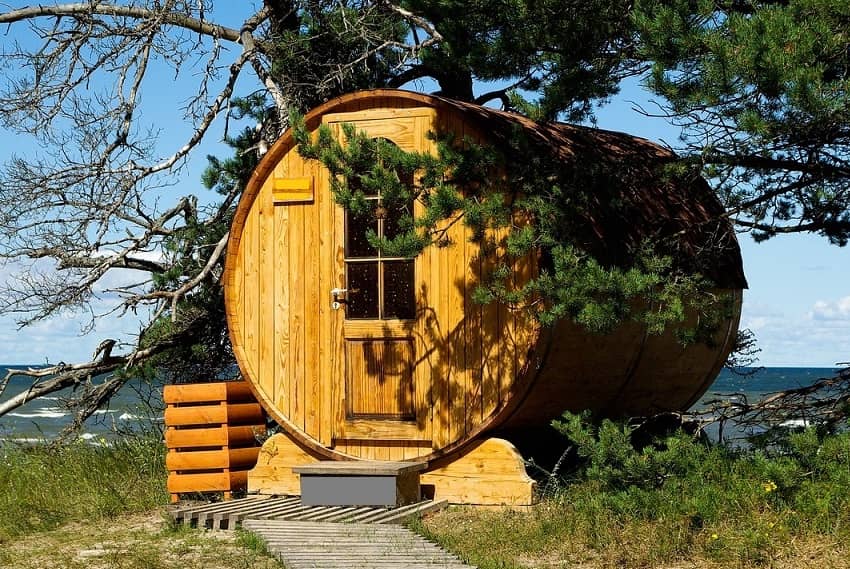
Ideally, you shouldn’t place the barrel stand directly on the ground either, but compared to no foundation, it’s still a major advantage that other sauna types don’t offer ready-made.
The biggest difference (and a con to some) between a traditional outdoor sauna and a barrel is that the latter doesn’t offer vertical seating options, leaving your feet at ground level where the air can be significantly colder as heat always rises up.
10. Cylinder sauna
With a cylinder sauna, what you lose in foundation, you gain in height.
Some sauna brands use the words barrel and cylinder synonymously, meaning there is no difference between the two. In other instances, a cylinder means a vertical barrel:
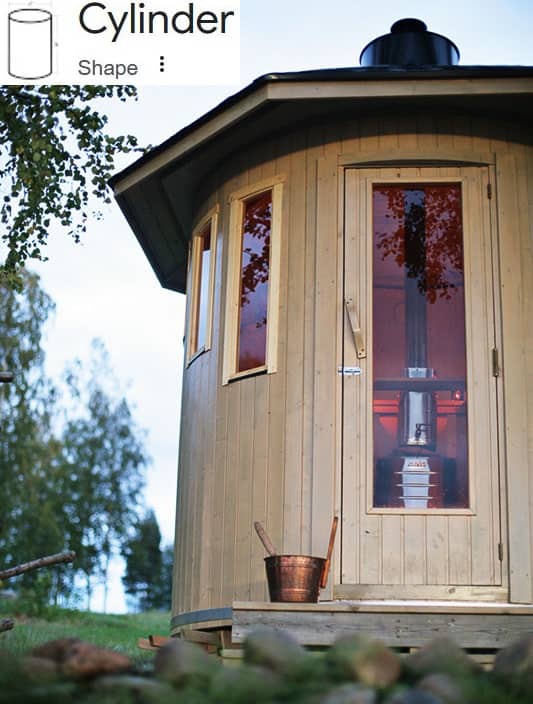
A cylinder sauna takes even less space than a barrel, so this may be an excellent choice for the smallest yards.
The best cylinders also have the benches on two levels, like the model above, which is perfect and an improvement to horizontal barrels.
If you find a cylinder sauna with only one bench relatively low and a lot of empty space in the ceiling, that’s not the best choice: you lose heat the quickest as heat always rises towards the ceiling, and you’re not given an option of sitting higher.
11. Outdoor infrared/hybrid sauna
The indoor versions of these sauna types are already presented above.
Some sauna brands just add a roof to an indoor infrared sauna and then call it an outdoor version, but obviously that’s not enough for humid or colder climates.
What’s truly needed is total weather-proofing and proper insulation to help with higher electricity bills; during freezing winters, heating an outdoor sauna with electricity costs significantly more than having an indoor version of the same sauna.
An outdoor hybrid sauna offers both, an infrared and traditional sauna.
12. Sauna tent
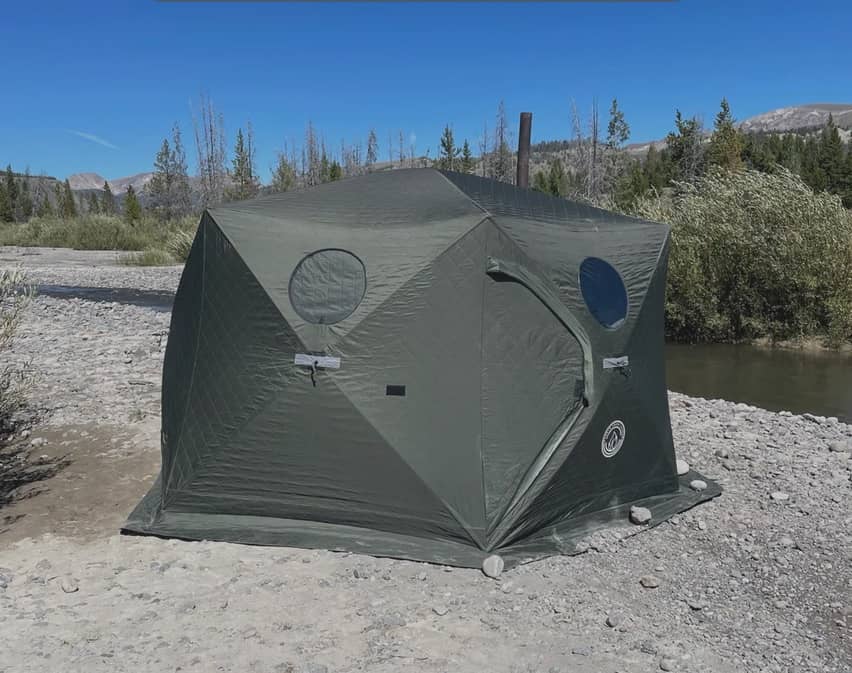
While there are so many gimmicky sauna types available in the US, sauna tents are a pleasant exception. They’re all intended for outdoor use.
Although sauna tents are technically portable, and the tent material is light and easy to carry with you, the wood-burning stove, rocks, and benches are obviously heavy and not ideal to carry when you’re on foot.
That’s why for many, a sauna tent is often a more solid than portable option.
Some sauna tents are for temporary use only, meaning you should clean and fold the tent after each use, while some models can be left outside on your yard.
The best sauna tents come with a proper wood-burning stove, enough rocks for sufficient heat retention, and 2-tier sauna benches:

13. Mobile sauna
This is one of the most self-explanatory sauna types: if you want a sauna on wheels, then a sauna trailer or sauna wagon is the right one for you.
Compared to a non-movable outdoor sauna, the biggest advantage of a sauna wagon is that you can even rent it out and make some extra cash.

14. Sauna boat / floating sauna
This is a sauna cabin mounted onto a pontoon, allowing you to go for a swim anytime in between saunaing.
This type can either be tied to the docks or be surrounded by water all around, meaning that you have to row or boat to get to the sauna.
Below’s an example of a floating sauna cabin by FinnMark.

15. Smoke sauna / savusauna in Finnish
I want to include this since it’s very distinct and among the oldest sauna types; however, smoke saunas are not commercially available in the US.
Unless you’re a builder and a hard-core sauna expert, this won’t be the home sauna for you. Heating up and preparing a smoke sauna for use require pretty exact science and can take an entire day.
What makes a smoke sauna unique is that once the sauna stove is heated by burning wood, there’s no chimney to let the smoke out. There are, however, several ventilation holes that are open during the heating process. Initially, wood has to be added every 15 to 20 minutes, and you’re not supposed to leave the sauna during this time.
About 3 hours later the smoke is aired out and sauna surfaces washed. The sauna stays warm despite ventilation since the stove with sauna rocks is typically very large and retains heat efficiently for a long time.
Water is thrown on the sauna rocks slowly in a controlled manner to produce heat and steam just like in a traditional wood-burning sauna.
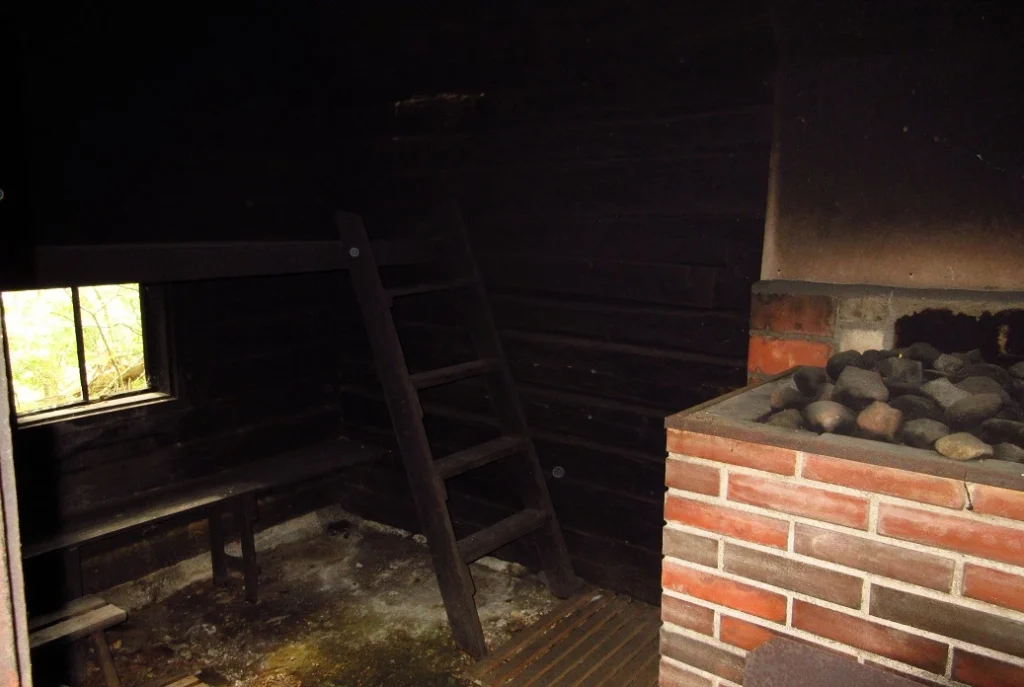
Honorable Mentions: Sauna Types that Are Variations of Traditional Outdoor Saunas
There are a few sauna types that are not distinct enough from traditional outdoor saunas to be listed separately but that still deserve to be mentioned.
- Yurt sauna
This can be one of the biggest sauna types, making it a good choice when you have a whole group of sauna-goers.
Although yurts don’t necessarily seem the sturdiest or most efficient options for saunas, they do heat up really well even in cold climates. You can see examples with pictures here.
- Pod sauna / Igloo sauna

In addition to the nice shape, it makes sense to maximize the space in the sitting area while keeping ceiling space to a minimum.
One other thing worth mentioning is the roof that covers the walls too; this kind of roofing is much more protective than what barrel saunas come with.
- Cube sauna
Apart from the modern and sleek shape, a rounded cube sauna resembles either a barrel (when the roof ends midway) or a pod (when the roof covers the walls entirely):
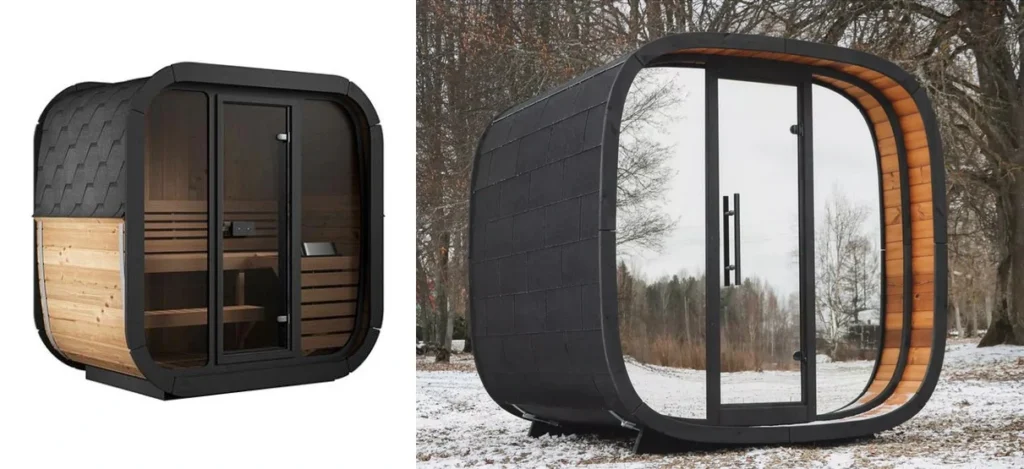
Sauna Type Comparison: Dry Sauna vs. Wet Sauna
Many Americans are under the impression that traditional saunas are dry saunas whereas a wet sauna means a “steam sauna” which in reality means a steam room.
In Finland, on the other hand and where saunas come from, everybody knows there’s nothing dry about saunas: nobody speaks of them as “dry saunas” and they’re certainly NOT used dry!
In fact, if you don’t pour water on the hot sauna rocks to produce steam (löyly), and therefore don’t make your previously dry sauna humid throughout your sauna session, your so called sauna is no sauna at all.
In Japan where they are very impressed and influenced by the Finnish sauna, millions of people have realized traditional saunas aren’t meant to be used dry and are learning how to pour löyly!
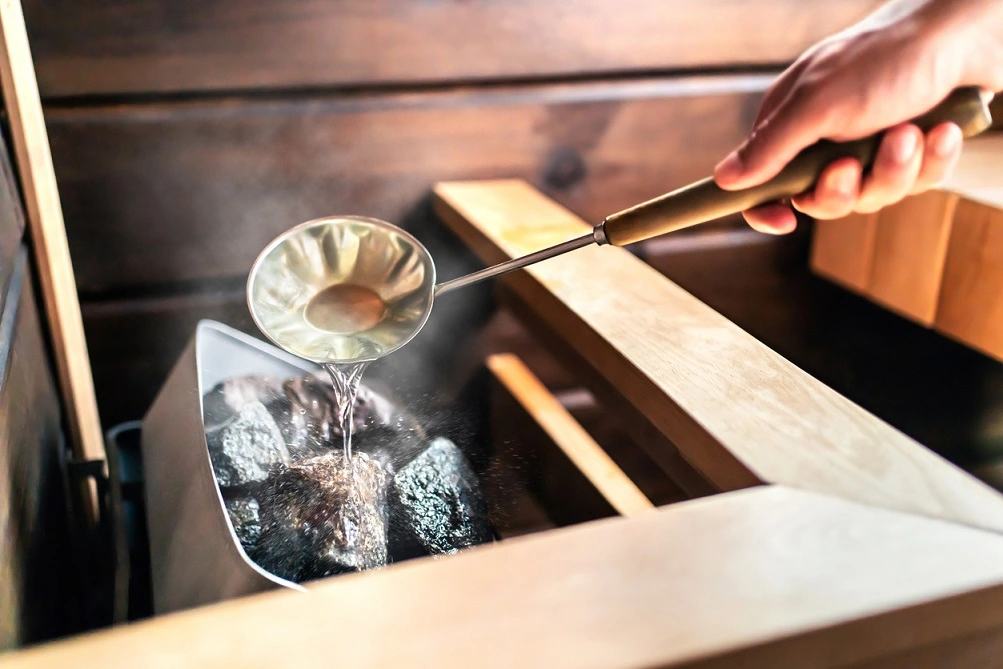
Steam (löyly) is the MOST IMPORTANT PART of saunaing and the sole reason why people sauna.
Why anyone equates steam with dryness would be beyond me unless I knew that most saunas in the US and Canada are used incorrectly.
People are not pouring löyly even though the sauna heaters are Finnish or Estonian and ALWAYS meant to be used with water. Instead, they sit in a dry sauna and speak of dry saunas. That’s such an unnecessary loss!
Sometimes it’s believed that throwing water is just an option and that an electrical appliance like a sauna heater can’t tolerate water, but none of that is true:
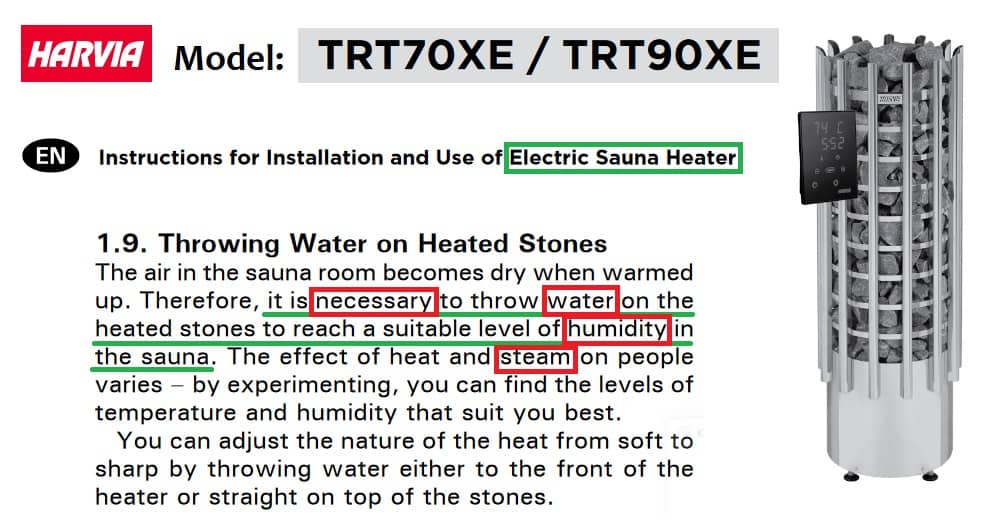
To recap, are traditional saunas dry saunas? The answer is no. How could a sauna that’s built for water use and steam production be a dry sauna?
What type of sauna is dry, then? The only dry “sauna” is an infrared one although it’s called a sauna only for marketing purposes.
Frequently Asked Questions (FAQ)
1. Which type of sauna is best, infrared or steam?
When answering what sauna is better, infrared or steam, there’s confusion about what steam means in this case. Some people know traditional saunas are steamy whereas some think steam in this context means a steam room.
As I know traditional saunas are much more sought after than steam rooms (for home settings at least), I’m going to assume this question means which is best, a traditional steamy sauna or an infrared one.
Objectively speaking, traditional steamy saunas are the best. They have been used for centuries, have been studied extensively, and offer more health benefits than infrared heat cabins that aren’t even real saunas.
But if you’ve been to an infrared heat cabin and know you personally prefer dry heat that makes you sweat profusely at lower temperatures, then infrared can be the better choice for you.

2. What type of sauna is best for your health?
As traditional saunas have been studied the most and for the longest, sometimes with over a thousand participants per study that lasted for 15 years, it’s safe to say that traditional saunas are best for health.
The research on infrared saunas is still very limited, and the studies that do exist are very small, covering a very short saunaing period and having only a handful of participants.
Whenever you hear sauna manufacturers say infrared saunas offer health benefits that traditional saunas don’t, just know there’s no evidence to back up these claims.
I’ve also seen articles with infrared sauna in the headline that list scientifically proven health benefits of saunaing, but in reality, all the research was done on traditional saunas. This means there are even less studies on infrared saunas than one might think.

Scientifically proven health benefits of traditional saunas include:
✅ improved cardiovascular health – regular sauna use has been linked to a reduced risk of cardiovascular diseases, lower blood pressure, and improved endothelial function (Source: PubMed)
✅ lowered risks of dementia and Alzheimer’s disease – it’s not known whether these are caused by some physical effect or if the enjoyable experience itself (in this case, saunaing) prevents or postpones the development of memory disorders (Source: PubMed)
✅ enhanced relaxation and stress reduction – saunaing induces relaxation and reduces stress levels, increases levels of calmness and endorphins, promotes muscle relaxation, and improves sleep
✅ improved respiratory function – sauna bathing may benefit respiratory health by clearing airways and improving lung function as the warm, humid air helps alleviate symptoms of common colds, asthma, and chronic bronchitis (Source: PubMed, 1 and 2)
✅ pain relief and muscle recovery – sauna sessions can provide relief from muscle soreness, joint pain, and arthritis symptoms as the heat relaxes muscles, improves circulation, and reduces inflammation, aiding in faster recovery after exercise or injury (Sources: PubMed and BMC Medicine)
Infrared saunas seem to share some of these benefits although much more research is needed on them specifically.

Final Thoughts
All sauna types fall under the main categories of indoor and outdoor saunas. Some options are portable while the majority are solid.
Although infrared saunas have gained popularity in recent years, the biggest sauna populations prefer traditional, steamy saunas that also have proven health benefits.
When not talking about infrared saunas, a “dry sauna” is mostly a delusion based on incorrect use or poor understanding of traditional saunas. Most saunas are, in fact, much more humid than dry.
Saunaing is for relaxation and has health benefits for both mind and body. It’s NOT about working out, endurance, and pain.
Finally it’s your turn to have a say! Which sauna types have YOU tried or wish to test in the future?
